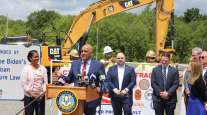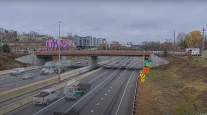The Day (New London, Conn.)
Connecticut Officials Weigh Toll Costs, Benefits

[Stay on top of transportation news: Get TTNews in your inbox.]
While local and state officials stress the need for transportation infrastructure improvements, they also have concerns and questions about the governor’s plan for tolls.
While some support tolls to fund improvements to the state’s highways and bridges, others want more details on the plan and some are worried about the potential clogging of local roads and financial impact to residents.
Gov. Ned Lamont this month unveiled CT2030, his $21 billion transportation plan for 10 years’ worth of improvements to Connecticut’s highways, airports, ports and public transportation system.
The proposal calls for funding 14 infrastructure projects — including the rehabilitation of the northbound span of the Gold Star Memorial Bridge between New London and Groton and improvements to the Interstate 95 Exit 74 interchange with Route 161 in East Lyme — through revenue from new overhead electronic toll gantries.

Lamont
“Rather than delay construction and burden CT taxpayers with the total cost of improvements plus interest, 14 CT2030 projects will be funded by the implementation of a new and modest user fee beginning in 2023,” the plan states.
It also calls for directing 5% of the revenue generated from each tolling gantry to the host municipality.
The base fares for the tolls would range from 50 cents to $1 for cars; $1.25 to $2.50 for medium-size trucks; and $3.50 to $7 for heavy trucks. Connecticut residents would get a 20% discount if they have a transponder, or electronic device affixed to a vehicle that automatically collects the toll fees.
Vehicles with a transponder would not “pay more than one round-trip user fee per gantry” within a single day, the proposal states.
Vehicles that don’t have a transponder would be charged 25-50% more than the base rate due to the cost of mailing the bill, according to the proposal.
The toll for the $300 million to $415 million Gold Star Bridge project would have a base fare of $1 for cars, or 80 cents for Connecticut cars with an E-Z Pass, which receive a 20% discount off all base fares. Heavy trucks would pay $7. The revenue directed locally would be $1,081,185.
One gantry would be located before the northbound side of the bridge, and another placed before the southbound side, according to Kevin Nursick, spokesman for the state Department of Transportation. Repairs to the southbound span have been completed, he said, while work on the northbound side will begin next year. The work, which will strengthen the superstructure and replace the deck, will be done in three phases.
The money generated by the tolls would be used to pay back the federal loans taken out for the project, he said.
The toll associated with the $140 million to $220 million East Lyme project would have a base fare of 75 cents, or 60 cents for Connecticut E-Z pass cars, and cost heavy trucks $5.25. This project is scheduled to begin in 2022. A projected $1,310,424 would be allocated to East Lyme annually.
Nursick said that without another funding source, such as tolls, there is no guarantee that this project would go forward.
Support and Opposition
Sen. Cathy Osten (D-Sprague) said Senate Democrats met for more than two hours with the governor Nov. 13. She said they like the idea of doing the projects that need to get done, but want to be sure they are providing the correct funding to afford those projects.
“We support the plan, and the financing is yet to be decided,” Osten said.
Sen. Paul Formica (R-East Lyme) said he agrees with the governor that transportation is a key issue for residents and businesses in Connecticut and needs to be addressed in a bipartisan manner. He said he liked that the governor’s latest plan moved in the right direction to reduce the overall number of proposed toll gantries to 14, and that the governor is open to discussions.
“I think that’s encouraging. We remain opposed to any tolling but again we understand we have to find a solution, so we’re happy to listen and have these discussions,” Formica said. He said Nov. 13 the Republican Caucus is working with the governor to have further discussions after being briefed on his proposal.
Senate Republicans on Nov. 14 released a no-tolls alternative that would transfer money from the Budget Reserve Fund toward unfunded pension liabilities when the fund exceeds 5% of General Fund appropriations, resulting in savings that assist the Special Transportation Fund. It would re-establish the Transportation Strategy Board to vet all projects, and utilize federal borrowing programs for lower interest rates.
TODAY: @CTSenateGOP presented #FASTRCT, a NO TOLLS, NO TAX INCREASE transportation plan for #Connecticut
Click the link to read the plan: https://t.co/Hu8e9qntIE #CTPolitics https://t.co/SbQA8odYGt pic.twitter.com/l924hWa0Fa — CT GOP (@CTGOP) November 15, 2019
The plan, called Fiscal Accountability & Sustainable Transportation Reform CT (FASTR CT), would invest $18 billion in transportation infrastructure between now and 2030.
Senate Republicans say they are offering the alternative because the people of Connecticut already have been taxed enough, and given the state’s history, they have “serious concerns about trusting government to manage a new revenue source.”
Lamont responded in a statement by saying that while he appreciates the “proposal to partially fund much-needed infrastructure investments, taking money out of the Rainy Day Fund is a risky proposition that requires serious evaluation.”
Sen. Heather Somers (R-Groton) in a statement Nov. 14 called the Senate Republicans’ alternative a “thoughtful, long-term solution which shows a path forward to adopt responsible fiscal policies and establish accountability without asking for more from overburdened taxpayers.”
Somers had said by phone Nov. 13 that she has overwhelmingly heard from people in her district who oppose tolls.
“People are especially irate that there would be a toll on the Gold Star Bridge,” Somers said. She has heard concerns from people who already find the bridge challenging to cross and from ambulance companies that have to use the span during emergencies.
“Tolls hurt the middle class and the lower middle class the most,” Somers added and pointed out that her district still is struggling to recover from the recession.
Rep. Christine Conley (D-Groton) raised concerns over the impact of the governor’s plan on residents.
“I have serious concerns with any transportation plan that makes it more expensive for Groton residents to access essential services, like medical care, in New London or other parts of the state,” Conley said in a statement. “The Republicans have announced that they are going to propose a plan that does not have any tolls. I look forward to reviewing that plan. There is no doubt that the Gold Star Bridge needs to be replaced at a cost of hundreds of millions of dollars. Once everything is on the table, I will ask the same question of all the plans — is it a cost effective and fair way to pay for replacing the Gold Star Bridge?”
State Rep. Anthony Nolan (D-New London) said he thought the latest plan was an improvement compared with the last one. He said features including the small cost to go over the bridge, discounted rate for residents, transparency in regard to funding and revenue sharing with host municipalities addressed some of his constituents’ concerns.
He said he hopes to hold a town hall-style meeting in New London, in which he would invite other legislators and the Lamont administration, so his constituents could hear more about the proposal and ask questions.
“I really want to hear from my constituents,” he said.
He said about 125 people, who support implementing tolls so the state can make necessary infrastructure improvements, reached out to him to say they were glad to see some of the small changes in the plan. About 25 people who opposed tolls said that while the plan is “a start,” they are not considering it a win.
Though Groton and New London share the Gold Star Bridge, Nolan said he hoped that each could receive 5% of the revenue. “It’s still a work in progress,” he said. “I’m hoping that we don’t have to share the 5%.”
State Rep. Holly Cheeseman (R-East Lyme) said she was pleased to see for the first time a detailed proposal on what projects would be addressed and where the money would go. She also liked that the governor investigated the possibility of low-interest federal loans. That said, she still had questions and misgivings about the plan.
One of those questions is what happens when the revenue projections underperform, for example when people decide to avoid the tolls or when the state gets fewer out-of-state drivers, and what would happen to the revenue share promised to municipalities?
She pointed out that, despite a Democratic majority in Connecticut’s government, “I think the fact that it [tolls] isn’t the law of the land is because legislators on both sides have real misgivings about putting another tax on the citizens of Connecticut.”
Local Officials Weigh In
New London Mayor Michael Passero has publicly supported tolling and stressed that the state has to find a sustainable revenue source to pay for infrastructure needs, including the rehabilitation of the Gold Star’s northbound span.
He said the bridge is in need of the work and it will be a large and important construction project, both employment-wise and investment-wise.
“This bridge is so crucial to the economy in southeast Connecticut that it needs this investment critically,” Passero said. “The project will be an economic driver, and, if the tolls are the sustainable revenue source to get this work done, then I’ll accept this.”
He added that he believes the proposal has enough provisions that will minimize the economic effects on the people living in the area that use it daily or multiple times a day.
City of Groton Mayor Keith Hedrick said he’s had the opportunity to review the plan and understands the state needs to conduct repairs to bridges and other infrastructure.
“We have postponed these repairs or otherwise diverted the gas tax revenue for the repairs,” Hedrick said. “The repairs must be completed to the Gold Star Bridge, or it may become impassable. It is a critical conduit across the Thames River. I support the repairing of the Gold Star Bridge.”
But he said he is concerned about the tolls’ potential negative impact on moderate- to low-income residents and employees. He said to get a discount, people need to have a transponder, which in turn must be linked to an account or credit card.
“Many moderate- to low-income employees cannot get a credit card and therefore they will be subject not only to the full cost of the gantry fee, but they will also pay for every time they cross the gantry,” Hedrick said.
#CT2030 is a plan to transform Connecticut's transportation system to reduce congestion and make travel quicker, safer, convenient, and reliable.
This includes improvements to our:
Roads
Trains
Buses
Airports
Ports
Check out the plan at https://t.co/lh90R1Veut pic.twitter.com/KSS1rC0E18 — Governor Ned Lamont (@GovNedLamont) November 7, 2019
Town Mayor Patrice Granatosky said by email that, like others, she has concerns with the governor’s latest plan. However, she said, “We all agree that we want our infrastructure to be properly maintained.”
She added, “The Gold Star Bridge is a vital link in Southeastern Connecticut and as such, must be kept in good repair. Bridge travel is a necessity for many Groton residents for work and [health care] needs. We have no practical alternative, and therefore I have concerns for the ability of Groton residents to meet their needs in an efficient and affordable manner.”
East Lyme First Selectman Mark Nickerson said the proposed toll in East Lyme would put added pressure on the small town’s roads.
“I’m very concerned about our town being able to take on traffic coming off the highway throughout the year,” he said.
Nickerson said that while the town’s share of revenue from the tolls would help with additional police presence, it wouldn’t unclog the road — and he was concerned about the uncertainty of actually receiving that money.
“The state has a long, long history of promising towns money and then taking it back,” he said. “There would need to be a guarantee, not just a handshake, that this money would last as long as the tolls are up.”
Want more news? Listen to today's daily briefing:
Distributed by Tribune Content Agency, LLC




